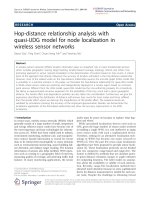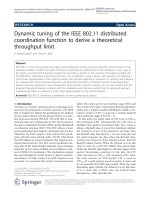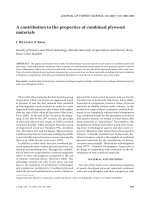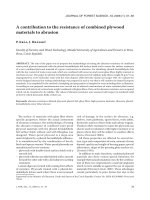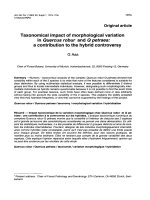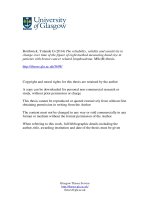A Contribution to Performance Analysis Approach of the IEEE 802.11 EDCA in Wireless Multi-hop Networks
Bạn đang xem bản rút gọn của tài liệu. Xem và tải ngay bản đầy đủ của tài liệu tại đây (529.01 KB, 10 trang )
VNU Journal of Science: Comp. Science & Com. Eng., Vol. 31, No. 1 (2015) 45-54
45
A Contribution to Performance Analysis Approach of the
IEEE 802.11 EDCA in Wireless Multi-hop Networks
Minh Trong Hoang*, Minh Hoang, Duc Cong Le
Posts and Telecommunications Institute of Technology, Hanoi, Vietnam
Abstract
The IEEE 802.11e standard has been introduced to support service differentiation for wireless local area
networks. In wireless multi-hop networks, the performance of IEEE 802.11e EDCA has to confront with some
practical problems such as unsaturation traffic and hidden node problem. Hence, this problem has attracted
numerous studies in recent years, in which several investigations use analytic model to evaluate the performance
due to its accuracy aspect. However, the accuracy and complexity of analytical model depends on a range of
assumed parameters. The complexity caused by the introduction of realistic conditions in wireless multi-hop
networks is the major challenge of current studies in this field. To overcome this challenge, this paper proposes
an analytical model which covers full specification of IEEE 802.11e EDCA. To reduce the complexity, the
model is simplified by decomposing the problem in two models based on Markov chain that can be easily solved
by numerical method. The proposed model is presented in the theoretical aspect as well as numerical results to
clarify its accuracy.
© 2015 Published by VNU Journal of Science.
Manuscript communication: received 01 December 2014, revised 29 January 2015, accepted 10 February 2015
Corresponding author: Minh Trong Hoang,
Keywords: IEEE 802.11e EDCA, Virtual collision, Multi-hop network, Hidden node, Markov chain.
1. Introduction
The IEEE 802.11 has become ubiquitous
and gained widespread popularity for wireless
multi-hop networks. To adapt the quality of
service requirements of multi-media
applications, the IEEE 802.11e Enhanced
Distributed Channel Access (EDCA) has been
standardized [1]. EDCA provides differentiated,
distributed access to the wireless medium for
node based on eight user priorities which are
mapped into four Access categories in MAC
layer. Three characteristic parameters of access
categories are Contention Window (CW),
Arbitrary Inter-Frame Space (AIFS) and
Transmission Opportunity (TXOP).
In the recent years, a large body of work has
appeared in the literature to investigate
performance of IEEE 802.11e EDCA through
analytical models. Most of them focused on the
impacts of the parameter differences on
network performance. However, due to very
high complexity of presenting an analytical
model which addresses all the features and
details of the standard, the models are limited or
ignore some important specifications to
simplify the modeling. Many analytical models
of IEEE 802.11e are extended from Bianchi
model for IEEE 802.11 Distributed
M.T. Hoang et al. / VNU Journal of Science: Comp. Science & Com. Eng., Vol. 31, No. 1 (2015) 45-54
46
Coordination Function (DCF) [2]. They fall into
two cases: Saturations and unsaturation
conditions. Under saturated condition the
authors in [3, 4] proposed analytical models to
capture AIFS and contention window
differentiation to analyze the throughput and
delay of the IEEE 802.11e. However, the
impact of AIFS differentiation is not covered.
The proposed analytical model in [5] use the
AC-specific EDCA cycle time for predicting the
EDCA saturation performance but it can not
clarify the impact of the contention window.
Under unsaturated condition, the authors in
[6] used frame transmission cycle approach to
consider the difference of AIFS. The model
analyzes WLAN based on IEEE 802.11e EDCA
in detail; however it is not applicable to multi-
hop networks. The proposed analytical models
used renewal reward approach to extend a
saturation model of single cell IEEE 802.11e to
comfort with both unsaturated and saturated
conditions [7, 8]. In [9], internal collisions in
each node, concurrent transmission collisions
among nodes, differences of CWs among ACs,
and effects of contention zone are considered.
However, these models in [7, 8] do not count to
the hidden node problem, and the model in [9]
focus only on throughput analysis in multi-
hop string topology. It is clear that, the lack
of input factors in analytical model can lead
to its inaccuracy in the performance analysis
problem [10].
To our best knowledge, there isn’t any
analytical model considering fully of
parameters of IEEE 802.11e EDCA with
realistic conditions including contention
window, AIFS, virtual collision, hidden nodes
and unsaturated condition in multi-hop
networks. Hence, in this paper, a novel
analytical model enhanced from our previous
work is proposed to overcome these previous
limitations to analyze throughput and access
delay multi-hop network performances [11].
The remains of this paper is structured as follows:
In Section 2, the proposed analytical model is
presented in full details. Main numerical results
and our discussions are adopted in Section 3. The
conclusion is drawn in Section V with the
indication of our future work.
2. Analytical Model
To capture quality of service and priority
characteristics of IEEE 802.11e EDCA, we
used our previous analytical model with some
modifications [11]. We specialized the node
state model to AC sub-node state model which
different between ACs by EDCA parameters.
We also propose the channel state model and
transmission probabilities to take AIFS, CW
values difference and virtual collision into
account. In the following subsections, we
describe our assumptions and the analytical
model in detail.
2.1. Assumptions and Notations
Considering an IEEE 802.11e EDCA based
network containing n nodes distributed as a
two-dimensional Poisson process with density
γ. The network works on single radio single
channel mode with error-prone condition. Every
node has four ACs defined in the standard and
homogeneous physical characteristics. Assume
M is the average number of nodes in the area A,
the probability of finding n node in area A is
( )
, , .
!
n
M
M
p n M e M A
n
γ
−
= =
M.T. Hoang et al. / VNU Journal of Science: Comp. Science & Com. Eng., Vol. 31, No. 1 (2015) 45-54
47
The problem of hidden nodes is illustrated
in Figure 1. In which, node i transmits to node j
with the present of hidden node k in the same
time. The hidden area A
H
depends on distance
between transmitter and receiver (x), and then
the average number of nodes in hidden area
is
( )
H H
M A x
γ
=
. Some main notations in this
paper are represented in Table 1.
Figure 1. A hidden node scenario.
DR
Table 1. Notation of parameters in our model
Index Parameters Notation
1 Radius of transmission range
t
R
2 Radius of sensing range
s
R
3 Density of node’s distribution function
γ
4 Average number of nodes in node’ sensing range
M
5 Average number of nodes in node’ transmission range
N
6 The average number of node in the hidden area
H
M
7 Network throughput
Th
8 Duration of a PHY slot
σ
9 Arrival rate (lambda)
λ
10 Maximum retry limits (short:4, long:7) m
11 Prob.{ a node (4 ACs) transmits a packet in a time slot}
t
p
12 Prob.{ successful transmission in a time slot}
s
p
13 Bit error rate (BER)
b
p
According to the principle of CSMA/CA
mechanism, all ACs follow an exponential
back-off scheme that a discrete back-off value
which is chosen uniformly from zero to CW and
reduced by one when the medium is free for a
slot time. When back-off counter of an AC
reduces to zero, the first packet in the AC's
queue is transmitted. These transmitting
probabilities will be explored using two simple
Markov chains to model criteria of IEEE
802.11e operation. In which, a node is
considered as four individual sub-nodes
interplaying under internal virtual collision
handler called AC sub-node. For convenience,
we denote four access categories in IEEE
802.11e standard as
, (1,2,3,4);
j
AC j =
from
lowest to highest priority. The packet
transmission of each AC sub-node depends on
actions of other ACs in the same node and other
node in the same carrier sense area at the same
time. We define the probability of
j
AC
sub-
node transmitting a packet in a time slot by
(
)
j
t
p
,
which becomes
(
)
'
j
t
p
when count to virtual
collision, and completing transmission with
probability
(
)
j
s
p
. In a similar way,
t
p
and
s
p
are
probabilities of a node which transmits and
successfully transmits a packet in any AC,
respectively. Also define a virtual slot
[
]
( )j
E T
whose duration depends on what event belong to
any AC happens during the slot.
M.T. Hoang et al. / VNU Journal of Science: Comp. Science & Com. Eng., Vol. 31, No. 1 (2015) 45-54
48
2.2. AC Sub-node State Model
An AC sub-node is modeled by Markov
chain as shows in Figure 2. Steady states of an
AC sub-node state model includes four states:
idle, defer, failure and success, which are
denoted as
( ) ( ) ( ) ( )
, , ,
j j j j
i d f s
π π π π
respectively.
Figure 2. Markov chain
for AC sub-node state model.
The transition probability from defer to
success state for an AC sub-node depends on
three factors: successful sending (
( )
1
j
p
),
successful receiving (
( )
2
j
p
) and no error occurs
during transmission time. We consider a
network with imperfect channel which has
packet error probability
,
packet
e
p
(
)
1 1
packet
L
packet bit
e e
p p= − −
for both control and
data packets (notation as
/
,
RTS CTS Data
e e
p p
). We
have
( )
1
( )
( ) ( )
1
2
(1 ) ( )
n
j
j j
t t
t
n
p M p p p n M
p
∞
−
=
′
, = − × ,
∑
(2)
(
)
( )
( ) ( )
2
0
(1 )
j
n
j j
H t H
t
n
T
p M p T p n M
p
σ
∞
=
, , = × ,
−
∑
(3)
where
( )
j
T
is vulnerable time,
H
M
is average
number of nodes in the hidden area as shown on
Figure 1.
The duration times of two types of IEEE
802.11e access mechanisms are
( )j
Basic DATA
T AIFS T SIFS
δ
= + + +
, (4)
( )j
RTS CTS RTS
T AIFS T SIFS
δ
/
= + + +
. (5)
The transition probability of a node changes
from
defer
state to
success
state with Basis
access scheme is
(
)
( ) ( ) ( )
1
( ) ( )
2
( ) 1
( ) 1
Basic
j j j Data
ds t t e
j j Ack
H t e
p x p N p p
p M p T p
= , −
× , , −
(6)
And with RTS/CTS scheme is
(
)
( ) ( ) ( )
1
( ) ( )
2
( ) 1 1
( ) 1 1
RTS CTS
j j j RTS Data
ds t t e e
j j CTS Ack
h t e e
p x p N p p p
p M p T p p
/
= , − −
× , , − −
(7)
Finally, we have
( ) ( ) ( )
( ) ( ) ( )
0 0
2
t t
ds
R R
j j j
ds ds
p f x p x dx xp x dx
= =
∫ ∫
(8)
with the assumption each node transmits to
a random receiver in its transmission area with
equal probability of density function
( )
f x
depends on distance x,
( ) 2 0
t
f x x x R
= , < <
.
The transition probability of AC sub-node
changes from
defer
state to
idle
state is
( )
( ) ( )
( )
( )
1 if
0 else
j
j j
j
j
di
p
λ
λ µ
µ
− <
=
(9)
where
( )
j
µ
is service rate at an AC sub-node;
its value is calculated in Section 3.
The transition probabilities of AC sub-node
changes from
defer
to
failure
and from
defer
to
defer
state are
( ) ( ) ( )
j j j
df t ds
p p p
= −
and
( ) ( ) ( )
1
j j j
dd t di
p p p
= − −
.
From Figure 2, we have some constraints to
calculate the stable probabilities of AC sub-
node state:
( ) ( ) ( ) ( ) ( ) ( )
( ) ( ) ( ) ( ) ( )
( ) ( ) ( ) ( ) ( ) ( ) ( )
( ) ( ) ( ) ( ) ( ) ( )
;
;
;
1 1
j j j j j j
s d ds f d df
j j j j j
i d di i ii
j j j j j j j
d d dd i id f s
j j j j j j
ii id di dd df ds
p p
p p
p p
p p p p p p
π π π π
π π π
π π π π π
= , =
= +
= + + +
+ = , + + + = .
(10)
With some basic calculus, we have the
M.T. Hoang et al. / VNU Journal of Science: Comp. Science & Com. Eng., Vol. 31, No. 1 (2015) 45-54
49
steady states probabilities of the node state
model are:
( )
( )
( )
( )
( )
( )
( )
( )
( )
( )
( )
( ) ( )
( )
( ) ( )
( )
( )
( ) ( )
( )
( )
( ) ( )
1
2
1
2
2
2
j
di
j
id
j
di
j
id
j
di
j
id
j
di
j
id
j
j
di
i
j
p
j j
id
dd di
p
j
d
p
j j
dd di
p
j
j
ds
s
p
j j
dd di
p
j
df
j
f
p
j j
dd di
p
p
p
p p
p p
p
p p
p
p p
π
π
π
π
= ;
− − +
= ;
− − +
= ;
− − +
= .
− − +
(11)
2.3. Channel State Model
The channel around node (
i
) is modeled by
using four-state Markov chain as in Figure 3.
Figure 3. Markov chain for channel state model.
We denote steady states and their durations
by
, , ,
I C S D
π π π π
, and
, , ,
I C S D
T T T T
,
respectively. Furthermore, the
success
state is
derived from 4 sub-states denoted as
( )
, (1,2,3,4)
j
S j =
corresponding to four ACs.
The transition probabilities between
channel states in channel state model is
illustrated in the figure and there are some
transition probabilities equal to 1,
( )
1
j
CI DI SI
P P P
= = =
.
The transition probabilities
,
II IC
P P
and
ID
P
of channel around node are acquired by similar
arguments as in [11]:
( )
1
;
1
n
t
II
n
P p p n M
∞
=
= − ,
∑
(12)
( ) ( )
(
)
( )
1
2
1 1 1 , ;
IC
n n
t t t
n
P
np p p p n M
∞
−
=
=
− − − −
∑
(13)
4
( )
1
1
j
ID
IC IS IS
j
P P P P
=
= − − − .
∑
(14)
The transition probability from
idle
state to
each
success
state comprises two probabilities:
successful transmitting (
( )
1
j
IS
P
) and successful
receiving (
( )
2
j
IS
P
) for the given
j
AC
:
(
)
( )
1
( ) ( )
1
1
1
n
j j
IS s t
n
P np p P n M
∞
−
=
= − ,
∑
(15)
( ) ( )
1
( ) ( )
2
1
1
n
j j
IS I t A
n
P np p P n M
∞
−
=
= − ,
∑
(16)
in which,
( )
j
I
p
is the successful transmission
probability from node k in annulus
A
A
to a
node in the intersection area
I
A
(Figure 1),
( )
j
s
p
is
( )
j
s
π
examined in AC sub-node state
model as
( ) ( ) ( )
1 2
j j j
IS IS IS
P P P
= +
(17)
From these probabilities and the
relationship on Figure 3, the idle steady state
probability is
( )
4
( )
1
1
j
j
I I II C CI D DI SI
S
j
I II I
P P P P
P
π π π π π
π π
=
= + + +
= + −
∑
(18)
Thus, stable state probabilities of channel
model are
( ) ( )
( )
4
1
1
2 2 2
;
2
j j
IC
ID
I C D
II II II
j
IS
S
S S
j
II
P
P
P P P
P
P
π π π
π π π
=
= ; = ; = ;
− − −
= = .
−
∑
(19)
2.4. Derivation of Analytical Problem
Contrast to Bianchi’s approach that based
on the non-linear equations for unknown
M.T. Hoang et al. / VNU Journal of Science: Comp. Science & Com. Eng., Vol. 31, No. 1 (2015) 45-54
50
probabilities called collision probability and
transmission one, we propose relationship
between probability of transmission and their
successful probability from our two models as
described in previous sections.
The event a packet of
j
AC
is sent from the
AC’s queue to virtual collision handler happens
when node i changes from idle state to defer
state
( )
j
id
p
and channel around a node is idle
(j)
( )
P
Φ
and back-off process is finished (
( )
j
BO
P
).
We have
( ) ( ) ( ) ( )
j j j j
t id BO
p p P P
Φ
= × ×
(20)
The probability that channel around a node
is idle is different between ACs due to the
disparity in the AIFS value and can be obtained
from steady state probabilities of channel model
in (19):
( )
( )
( )
4
( ) ( ) ( ) ( )
1
( )
4
( ) ( ) ( ) ( ) ( )
1
j
j
j
I I
j j j j
I I C C D D S
S
j
j
I
j j j j j
I IC C ID D IS S
j
T
P
T T T T
T
T P T P T P T
π
π π π π
Φ
=
=
=
+ + +
=
+ + +
∑
∑
(21)
The probability of back-off counter reduced
to Zero in a given time slot (
( )
j
BO
p
) depends on
the average contention window at i
th
attempt
and failure steady state probability of AC sub-
node as formula
( )
( )
( )
( )
0
( )
( )
0
1
,
m
i
j
j
f
i
j
j
i
BO
avr
j m
i
j
avr
f
i
CW
P
CW
CW
π
π
=
=
= =
∑
∑
(22)
in which,
( )
2; 0, m
j
i
i
CW CW i= =
, the retry
limits m and contention windows
( )
j
i
CW
is
specified for a given
.
j
AC
From
( )
j
t
p
, we can derive probability of the
given AC in a node transmitting a packet to the
channel in a times lot with virtual contention
condition
( )
j
t
p
′
:
( )
4
( )
( )
1 .
j k
j
t t
t
k j
p p
p
>
′
= −
∏
(23)
Thus, the probability of a node containing
four ACs transmits a packet of any
, (1,2,3,4)
j
AC j =
to the channel around it in a
time slot is
4
( )
1
.
j
t
t
j
p
p
=
′
=
∑
(24)
2.5. Remarks
As described in the previous subsections,
the analytical model is decomposed by two
state models namely AC-node sub state model
and channel state model respectively. By the
decomposition, the main IEEE 802.11e EDCA
features is exactly captured under realistic
conditions. To evaluate its accuracy, the
network performance such as throughput and
access delay is examined by numerical
simulation as bellows.
3. Numeric Results and Discussions
We use MATLAB to calculate throughput
and delay performance from our proposed
model. Analytical results will be examined
under standard parameters of IEEE 802.11e
EDCA as shown in Table 2.
The average virtual time slot
[ ]
j
E T
from
the channel model can be estimated by
[ ]
( ) ( ) ( ) ( ) ( )
4
1
j j j j j
j
I I C C D D S S
j
E T T T T T
π π π π
=
= + + + .
∑
(25)
Table 2: Calculation parameters (IEEE 802.11 EDCA)
Parameter Value Parameter
Value
Payload (P) 1024 byte ACK 256 bits
AIFSN[1,2,3,4] [2,3,5,7] RTS 288 bits
CW
min
[1,2,3,4] [7,15,31,63]
CTS 256 bits
PHY header 128 bits Slot time 20 µs
MAC header 160 bits SIFS 10 µs
Basic rate 1 Mbps Data rate 11 Mbps
Propagation
delay (δ)
1 µs
M.T. Hoang et al. / VNU Journal of Science: Comp. Science & Com. Eng., Vol. 31, No. 1 (2015) 45-54
51
Thus, throughput
Th
is defined as the
number of payload bits successfully transmitted
in a virtual time slot
[
]
[ ]
4
1
,
j
S
j j
j
j
E P
Th Th with Th
E T
π
=
×
= =
∑
(26)
in which,
[ ]
E P
is average payload of DATA
packets. We denote the length of RTS, CTS, and
ACK packets as
, ,
RTS CTS ACK
L L L
, respectively.
The transmission durations of RTS, CTS, ACK
and DATA packets are
; ;
; .
RTS CTS
RTS CTS
basic basic
ACK
DATA
ACK DATA
basic data
L L
T T
R R
L
L
T T
R R
= =
= =
(27)
The time durations
, , ,
I C D S
T T T T
are
different with access categories and access
scheme applied. With the basic mechanism, we
have
( ) ( )
( ) ( ) ( )
( ) ( )
;
; ;
j j
S Data Ack
j j j
D S I
j j
C Data Ack
T AIFS T SIFS T
T T T
T AIFS T SIFS T
δ δ
σ
δ
= + + + + +
= =
= + + + + .
(28)
And with the RTS/CTS mechanism
( ) ( )
( ) ( ) ( )
( ) ( )
;
; ;
j j
S RTS DATA
CTS ACK
j j j
D S I
j j
C RTS CTS
T AIFS T SIFS T
SIFS T SIFS T
T T T
T AIFS T SIFS T
δ δ
δ δ
σ
δ
= + + + + +
+ + + + + +
= =
= + + + + .
(29)
The average access delay for any packet
belong to AC
j
is calculated as
[ ]
( )
[ ]
( ) ( ) ( )
1
( )
( ) ( )
1
( )
( )
1
1
1
1 .
m
i
j j j
s s
i
i
j
j j j
S C
k
k
m
m
j
j j j
s C
k
k
D p p
E T T i T
CW
p E T mT
CW
=
=
=
= −
× + + −
+ − × +
∑
∑
∑
(30)
From access delay
j
D
, we have service rate
j
µ
of
j
AC
can be calculate from
1
j j
D
µ
= .
Figure 4. Saturation throughput vs CW
min
and
number of nodes varying.
Firstly, we verify our proposed model on
saturation throughput with the value of
min
CW
and number of nodes in transmission range
varying (5, 10, 20 and 50). Our scenario uses
basic access mechanism to evaluate throughput
for a node composing all ACs. Although our
approach is different from Bianchi’s one, its
accuracy is confirmed by the same results as
shown in Fig 4 comparing with those in [2] in
case of the same input pattern (only AC
2
has
arriving packet)
Figure 5 illustrates the influence of packet
arrival rate on throughput performance of each
AC. The average number of nodes is set equal
to 4 to achieve highest throughput. The
significant difference in throughput represents a
priority of traffic affected by AC parameters
such as the CW size, the AIFS value, and the
virtual collision in IEEE 802.11e EDCA.
Figure 5. Normalized throughput of ACs against
packet arrival rate.
M.T. Hoang et al. / VNU Journal of Science: Comp. Science & Com. Eng., Vol. 31, No. 1 (2015) 45-54
52
Figure 6 shows the normalized through-put
of ACs depends on number of nodes in
transmission area (N). When node density
increases, not only the throughput of each AC
decreases significantly but the difference in
throughput also decreases due to more number
of nodes contending for bandwidth. Moreover,
from figure 5 and figure 6 we can observe the
serious impact of hidden nodes in throughput of
network, especially in multi-hop network
environments, which was investigated in [12]
and inadequately examined in [13].
Figure 6. Normalized throughput
of ACs vs number of nodes.
To investigate the influence of access
mechanisms on throughput, we verify the basic
mechanism and RTS/CTS mechanism by
varying number of nodes and payload size in
Figure 7 and Figure 8. From the figures, we can
see that basic access mechanism can provide
better performance in condition of small
payload, which is more suitable with live voice
and video streams. Otherwise, RTS/CTS can
assure performance of EDCA networks much
better when number of node increases or with
larger packet’s payload size as ftp flows.
Figure 7. Throughput of ACs vs number of nodes.
Figure 8. Throughput of ACs vs payload size.
Finally, in Fig 9 and Fig 10, we investigate
the differentiation between saturated and
unsaturated incoming traffic in multi-hop
networks based on IEEE 802.11e EDCA
through throughput and access delay of ACs
against number of nodes, respectively. We
observed that throughput and access delay
performance in unsaturated traffic case is
decreased much slower than saturated traffic
case when N increases. Otherwise, when
number of nodes is relatively small,
saturated traffic case can achieve significant
higher throughput.
M.T. Hoang et al. / VNU Journal of Science: Comp. Science & Com. Eng., Vol. 31, No. 1 (2015) 45-54
53
Figure 9. Unsaturated and saturated throughput vs N
Figure 10. Unsaturated and saturated access delay vs N
4. Conclusion
This paper presented the analytical model
which is enhanced from the model of 802.11
DCF based on Markov chains to analyze the
performance of IEEE 802.11e EDCA in multi-
hop networks. By dividing it into two joint
state models, the analytical model captures all
main characteristic parameters of IEEE 802.11e
EDCA such as CW, AIFS and virtual collision
in a simple way. Moreover, realistic conditions of
wireless multi hop networks based on 802.11e
EDCA such as hidden node problem and
unsaturated condition are introduced into the
model. The numerical results have been provided
to verify the accuracy of the proposed model; it
can be used to arrange contention factors of
EDCA to optimize QoS differentiation and
network performance.
References
[1] IEEE, - IEEE 802.11 Part 11: Wireless LAN
Medium Access Control (MAC) and Physical
Layer (PHY) Specifications, Amendment (8):
Medium Access Control (MAC) Quality of
Service Enhancement, 2005.
[2] Bianchi G., - Performance analysis of the IEEE
802.11 distributed coordination function, IEEE
Journal on Selected Areas in Communications,
18 (2000), pp. 535-547.
[3] Tantra J., Foh C. H., and Mnaouer A., -
Throughput and delay analysis of the IEEE
802.11e EDCA saturation, IEEE International
Conference on Communications, 5 (2005), pp.
3450- 3454.
[4] Peng F., Peng B., and Qian D., - Performance
analysis of IEEE 802.11e enhanced distributed
channel access, Communications, vol.4 (2010),
pp. 728-738.
[5] Inan I., Keceli F., and Ayanoglu E., -
Performance analysis of the ieee 802.11e
enhanced distributed coordination function
using cycle time approach,” in Global
Telecommunications Conference, 2007, pp.
2552-2557.
[6] Huang C. and Shioda S., - Analytical model for
IEEE 802.11e EDCA with non-saturated
stations, in Wireless Communications and
Mobile Computing Conference (IWCMC),
2013, pp. 437- 442.
[7] Zhao Q., Tsang D. H., and Sakurai T., - A
scalable and accurate non saturation IEEE
802.11e EDCA model for an arbitrary buffer
size, IEEE Transactions on Mobile Computing,
vol.99 (2012), pp. 1-5.
[8] Ramaiyan V., Kumar A., and Altman E., -
Fixed point analysis of single cell ieee 802.11e
wlans: Uniqueness and multistability,
IEEE/ACM Transactions on Networking,,
vol.16 (2008), pp. 1080-1093.
[9] Shimoyamada Y., Sanada K., and Sekiya H., -
Non-saturated and saturated throughput analysis
for ieee 802.11e edca multi-hop networks, in
Wireless Personal Multimedia Communications
M.T. Hoang et al. / VNU Journal of Science: Comp. Science & Com. Eng., Vol. 31, No. 1 (2015) 45-54
54
(WPMC), 2013, pp. 1-6.
[10] Tinnirello I. and Bianchi G., - Rethinking the
IEEE 802.11e EDCA performance modeling
methodology, IEEE/ACM Transactions on
Networking, vol.18 (2010), pp. 540-553.
[11] Hoang Trong Minh, Hoang Minh, - A Novel
Analytical Model to Identify Link Quality in
802.11 Mesh Networks, Journal of Science and
Technology, Vietnam Academy of Science and
Technology, ISSN 0866-708x. 2 (2012), pp. 1-16.
[12] Kosek K., - Problems with providing QoS in
edca ad-hoc networks with hidden and
exposed nodes, in INFOCOM Workshops,
2009, pp. 1-2.
[13] Liu X. and Saadawi T. N., - IEEE 802.11e
(EDCA) analysis in the presence of hidden
stations,” Journal of Advanced Research,
Special issue on Mobile Ad-Hoc Wireless
Networks2 (2011), pp. 219 - 225.
.


